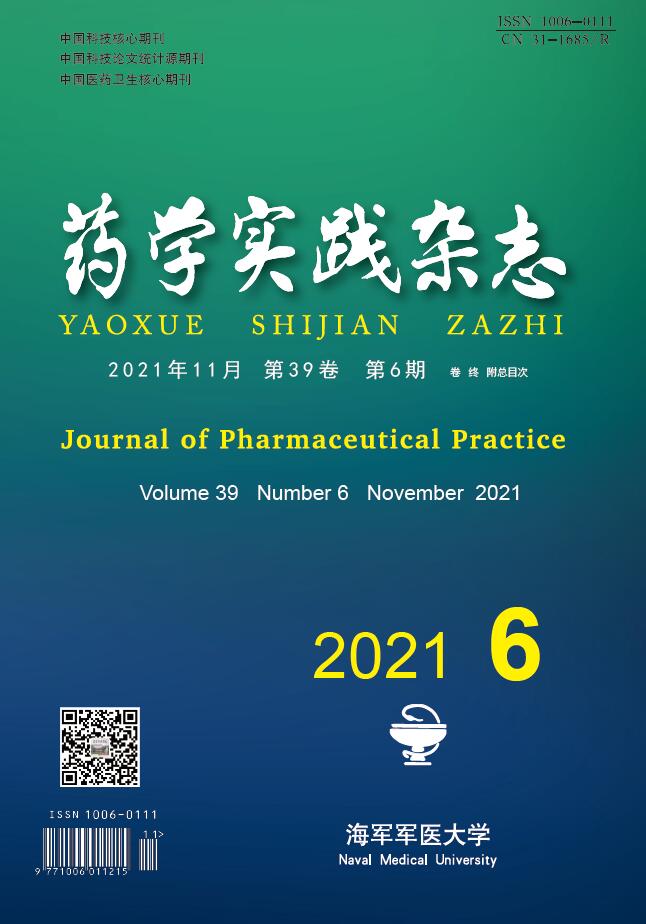-
社区药学服务(CPC)是以社区药师为主要成员的团队,基于医药专业知识及技能、药事管理法规和沟通能力,为大众提供直接的、负责任的与社区药物治疗相关的服务,确保社区药物治疗合理,以提高人群寿命、生存质量。社区药师参与慢性疾病管理,如糖尿病、高脂血症、艾滋病毒/艾滋病、心血管和呼吸道疾病,患者的药物治疗结果会有所改善[1]。CPC在预防和遏制COVID-19大流行的实践中也发挥了重要作用[2]。家庭医生在开展药物治疗方面需要药师的药学服务支持。目前,社区药师参与家庭医生团队,提供药学服务的实践仅限少数城区。我们的研究旨在评估郊区家庭医生团队成员对社区药师加入团队的态度和对CPC的认识,并分析开展CPC所面临的障碍,为今后的工作决策提供依据。
-
在2020年7月至9月期间,通过微信工作群转发的方式向崇明区18家乡镇的家庭医生团队提供了一份在线填写的问卷。这些人员分布在全区各个镇的社区卫生服务中心,包括全科医生、护士和公卫医师。纳入标准是受访者在编在岗。问卷收集整理后使用了描述性统计方法对家庭医生团队成员对CPC的认知、态度和障碍数据进行分析。参与调查是完全自愿的,在线问卷被设置所有参与者只能填写一次调查。该在线问卷没有收集参与者的IP地址,是完全匿名的。
-
调查问卷认知部分采用沈美团队[3]的研究,另外编制了家庭医生团队对CPC开展的障碍认同部分。该问卷在长兴镇的10名家庭医生成员中进行了初步测试,以验证问卷的内容、标准相关和结构效度,问卷经过修订后向全区发出。
-
数据采用Excel和SPSS 23.0进行分析。计数资料计算频数和构成比,用χ2检验不同专业组间分布频率的差异,检验水平为α=0.05。
-
共有555人回应了调查,其中,女性351人(63.24%)。全科医生187人(33.69%),护士226人(40.72%),公卫医师142人(25.59%)。工作5~9年的共196人(35.31%)。 本科及以上学历占50.63%,职称以初级和中级为主,分别占40.36%和33.33%,详见表1。
基本特征 人数(%) 性别 男 204(36.76) 女 351(63.24) 工作年限(年) <5 128(23.06) 5~9 196(35.31) 10~14 156(28.11) 15~19 54(9.73) >20 21(3.78) 专业 全科 187(33.69) 护理 226(40.72) 公卫 142(25.59) 学历 中专 85(15.32) 大专 189(34.05) 本科及以上 281(50.63) 职称 初级 224(40.36) 中级 185(33.33) 高级 146(26.31) -
研究结果显示,家庭医生团队三类成员在对 CPC 认知上的调查结果差异均有统计学意义(P<0.05)。被调查对象对CPC的认知情况详见表2。
调查内容 家庭医生 护士 公卫 Χ2 P 您了解CPC吗? 73.331 P<0.001 未听过 46(24.60) 126(51.22) 84(68.85) 听过,不了解 85(45.45) 86(34.96) 18(14.75) 了解 44(23.53) 20(8.13) 14(11.48) 熟悉 12(6.42) 14(5.69) 6(4.92) 您是通过什么渠道了解CPC的?(多选) 15.909* P=0.025 医生同事 10(5.35) 8(3.25) 3(2.46) 护士同事 25(13.37) 32(13.01) 22(18.03) 药师同事 32(17.11) 20(8.13) 12(9.84) 网络、电视、杂志等大众媒体 0(0) 5(2.03) 0(0) 医学专业期刊等其他渠道 5(2.67) 1(0.41) 0(0) 您是否了解社区药师工作内容和职责? 43.134 P<0.001 未听过 86(45.99) 110(44.72) 49(40.16) 听过,不了解 29(15.51) 75(30.49) 55(45.08) 了解 65(34.76) 58(23.58) 14(11.48) 熟悉 7(3.74) 3(1.22) 4(3.28) 您认为社区药师的工作内容有哪些?(多选) 295.169 P<0.001 药品供应 175(93.58) 235(95.53) 122(100) 处方或用药医嘱审核 126(67.38) 222(90.24) 84(68.85) 药品调剂 168(89.84) 202(82.11) 95(77.87) 开展处方点评与超常预警 114(60.96) 228(92.68) 86(70.49) 药品不良反应监测及上报 168(89.84) 200(81.30) 121(99.18) 开展抗菌药物临床应用监测 89(47.59) 165(67.07) 176(144.26) 开展药学查房 56(29.95) 184(74.80) 25(20.49) 协同医师做好药物使用遴选 54(28.88) 165(67.07) 36(29.51) 指导病房(区)护士请领、使用与管理药品 86(45.99) 144(58.54) 58(47.54) 提供药学咨询服务 126(67.38) 126(51.22) 99(81.15) 举办合理用药讲座与宣传 139(74.33) 205(83.33) 106(86.89) 为社区居民上门用药指导 101(54.01) 145(58.94) 54(44.26) 为医护提供药品与药学信息 104(55.61) 122(49.59) 65(53.28) 参与家庭医生团队开展社区慢病管理涉药服务 89(47.59) 153(62.20) 84(68.85) 做相关科研工作 48(25.66) 174(70.73) 20(16.39) 您认为目前CPC工作的开展情况如何? 60.098 P<0.001 举步维艰 57(30.48) 76(30.89) 68(55.74) 能正常运转 45(24.06) 52(21.14) 32(26.23) 配合很好 56(29.95) 48(19.51) 21(17.21) 不清楚 29(15.51) 70(28.46) 1(0.82) 您认为CPC人员中较好的专业背景是什么? 58.752 P<0.001 医学为主 36(19.25) 65(26.42) 65(53.28) 药学为主 99(52.94) 125(50.81) 55(45.08) 其他 52(27.81) 56(22.76) 2(1.64) 您在临床治疗中发现药品不良反应病例是否会主动知会药师? 56.362 P<0.001 会 26(13.90) 19(7.72) 22(18.033) 无所谓 36(19.25) 42(17.07) 55(45.08) 不会 125(66.84) 185(75.20) 45(36.89) 注:*表示Fisher确切概率结果。 -
结果显示,有67.38% 全科医生和81.42% 的护士认为“社区药师人员不足”是CPC开展的障碍,而认为“卫健部门的投资不足”是CPC开展的障碍的依次为全科医生(54.55%)、护士(69.03%)、公卫医师(60.56%)。其他障碍所占比例见表3。
障碍 全科医生 护士 公卫医师 卫健部门的投资不足 102(54.55) 156(69.03) 86(60.56) 社区药师人员不足 126(67.38) 184(81.42) 75(52.82) 社区药师专业技能不足 84(44.92) 65(28.76) 68(47.89) 社区药师时间有限 56(29.95) 79(34.96) 42(29.58) CPC需要很大投入 76(40.64) 68(30.09) 102(71.83) 病人期望不高 38(20.32) 88(38.94) 21(14.79) 同事不认可 45(24.06) 35(15.49) 36(25.35) 缺少更多的研究证据 86(45.99) 96(42.48) 64(45.07) 超越初级卫生保健服务范围 24(12.83) 66(29.20) 52(36.62) 其他 22(11.76) 50(22.12) 12(8.45) 总计 187 226 142 -
研究结果显示,126名(51.22%)护士和84名(68.85%)公卫医师“未听过”CPC,说明该区大部分家庭医生团队成员对CPC认知度是较低的。家庭医生主要是通过药师同事(17.11%)那里了解CPC的,而公卫医师主要从护士那里了解,这说明药师与全科医生沟通的较多,而与护士以及公卫医师接触较少,以至于他们对CPC不是很了解。社区药师在工作实践中应加强与护士和公卫医师的合作,向他们普及CPC知识,改变他们对传统的药学服务观念[4]。只有11.48%的公卫医师和23.58%的护士对于社区药师的工作内容和职责了解,而全科医生相对较多占比34.76%,这进一步说明大部分家庭医生团队成员对药师的工作内容是比较模糊的。社区药师应积极主动地参与到初级卫生保健服务中去,发挥和展示自己的专业功能。另外,超过1/3的全科医生和护士以及超多一半的公卫医师认为目前CPC工作的开展情况举步维艰,这说明CPC在该地区开展还是比较困难的,需要一定的时间。
认为“卫健部门的投资不足”是CPC开展障碍的全科医生有102人(54.55%)、护士156人(69.03%)、公卫医师86人(60.56%);认为“社区药师人员不足”是CPC开展障碍的全科医生有126人(67.38%)、护士184人(81.42%)、公卫医师75人(52.82%)。这表明财力缺乏和人力不足是CPC开展的两大主要障碍,因此为了提升CPC的可及性和工作效率,减少人员的支出,可以以信息化手段改善CPC,例如建立社区智慧药房,设置在线药师等[5],也可以通过电话的形式开展服务。姜兵武[6]和林秋晓[7]等研究发现,社区居民特别是老年居民对CPC的需求是非常迫切的,因此,政府相关部门应加大对CPC和社区药师队伍建设的支持。
相比于城区,CPC在郊区开展是有困难的,无论是财政投入,还是人才的引进都不及城区,而且由于郊区群众居住地分散,农民忙于田间地头,这使得CPC开展相对较难。鉴于此,为了CPC在城郊的发展,社区药师需要扎扎实实地学习和巩固临床基础知识、药学专业知识,努力增加药学专业知识储备和提升专业技能,增强法规意识,提高沟通能力[8]。另外,卫健部门应加强对CPC的重视和政策扶持,重视人才的培养和专业梯队建设,鼓励社区药师加入家庭医生,团队逐步完善家庭医生团队构成[9],多学科发挥基层医疗保健作用。
本次调查最大的局限性是基于微信平台展开,因此,本研究可能会有选择偏倚和信息偏倚。结合研究者所在单位现状,长兴镇社区卫生服务中心药学人员共有9人,学历分布情况为中专4人、大专4人、本科1人、有10年以上工作经验的仅有2名,所有药学人员均没有参加过社区药学培训,而社区药学照护实践经验更是不足。因此,本研究结果中家庭医生团队认为“社区药师人员不足”是CPC开展障碍的比例较高的结论是较为可信的,另外“卫健部门的投资不足”是CPC开展障碍的比例较高的结论也同样可信,正是由于卫生健康部门的忽视导致了基层社区药学人员缺乏继续教育培训,专业素质停滞不前,也使得社区药学人员无心开展社区药学实践。另外本中心全科医生团队对药学专业技术人员是比较排斥的,认为药学人员少、学历低等,加入团队工作的时机尚不成熟,这在本调查中也得以体现。
我们的调研结果对于郊区的社区药师清楚自己的工作定位和努力方向有指导意义,对于郊区卫健部门整合医疗资源,深入开展社区卫生服务,提升郊区居民就医满意度及药物治疗效果也有积极意义,对健康中国国策的实施提供一定经验。
Analysis of cognition, attitude and barriers to community pharmaceutical care among family doctor team members in Shanghai suburb
doi: 10.12206/j.issn.1006-0111.202104086
- Received Date: 2021-04-19
- Rev Recd Date: 2021-06-07
- Available Online: 2021-12-27
- Publish Date: 2021-11-25
-
Key words:
- family doctor team /
- community pharmaceutical care /
- cognitive /
- attitude /
- community pharmacists
Abstract:
| Citation: | SHI Libo, ZHU Tianzhu, SHEN Mei, WANG Zhongzhuang. Analysis of cognition, attitude and barriers to community pharmaceutical care among family doctor team members in Shanghai suburb[J]. Journal of Pharmaceutical Practice and Service, 2021, 39(6): 577-580. doi: 10.12206/j.issn.1006-0111.202104086 |








 DownLoad:
DownLoad: